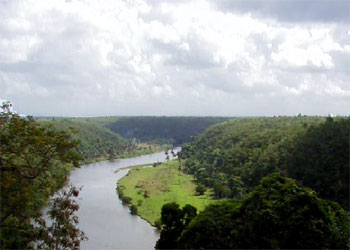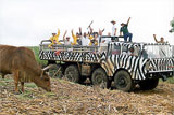|
|
|
|
Top Dominican Republic Destinations:
Puerto Plata hotels Punta Cana hotels Santo Domingo hotels Higuey hotels La Romana hotels See more hotels in Dominican Republic
World Destinations:
 Guides » Dominican Republic » Discovering the Dominican Republic Guides » Dominican Republic » Discovering the Dominican RepublicDiscovering the Dominican Republic
For some reason, people often overlook the Dominican Republic when it comes time to enjoy a relaxing vacation. This country offers spectacular mountain ranges, rivers, and waterfalls, and some of the most impressive white beaches you have ever seen. Then when you add in the areas of saltwater and the abundance of exotic wildlife, you can see why this place is so majestic. When visiting the Dominican Republic, there are so many things to see and do. For example, you can enjoy a boat ride through the mangrove forests looking for manatees or head to Bahia de Saman where humpback whales live.
The Dominican Republic is also a place of wonderful colonial architecture with a culture that celebrates life with a number of festivities. Of course, you cannot overlook the windsurfing and surfing competitions that are a huge part of the culture for the people of the Dominican Republic. In this article, we will provide you with a little history on this country along with current information that shows why it is truly a wonderful destination.  Currently, there are more than 8.5 million people living in the Dominican Republic with 2 million in the capital city of Santo Domingo alone. However, before the country grew to this size, the island was small, first being reached by people sometime around 2600 BC. These people used special dugout canoes to help them take advantage of the currents that would guide them from South America to the Antilles. Primarily Nomadic hunters and gatherers, these natives used tools handmade from stone, which meant very little was left for archaeologists to discover. Then around 250 BC, another group of people came to the island known as ancient Arawaks or Salanoids. Unlike the Nomadic people, this second group was known for making wonderful pottery, which was sold throughout the Caribbean and left for archeologists to find. Then around AD 700, yet another group of people came from Venezuela. With this type of hierarchical structure, you would have seen all types of lifestyles from farming to fishing to worship to art. Collectively, the people of the Dominican Republic called themselves Taino, which translates to “friendly people.” Living on Hispanola, experts estimate that around 400,000 existed at the time of Christopher Columbus’ arrival. However, word spread from another nearby island that the Dominican Republic was rich with gold. Anxious to get their hands on it, the Italian set sail at night but soon dashed their ship, the Santa Maria, offshore. After Columbus spent some time on the island, he renamed it Hispaniola, which means “Little Spain.” He then returned along with 1,000 colonists the next year eager to make this island the hub of Spain’s new empire. History tells us that the Taino people worked to make this happen but within six years of Columbus’ arrival, these people were working in horrific conditions and dealing with diseases known to Europe. Although some of the independent communities survived in some of the more remote islands, sadly, most of the original culture did not. Even after the Spanish settled near Isabela, they abandoned it just a few years later. With this, the settlers moved to what we know today as Santo Domingo. Although there was some gold on Hispaniola, it ran out quickly, meaning that Santo Domingo lost its appeal, especially once Peru and Mexico were found also to offer both gold and silver. At this time, pirates came to the Spanish settlements, specifically to the area that we know today as Haiti, ransacking and taking whatever they liked. Tired of fighting, the Spaniards ceded the island to France in 1697. Over the years, the Dominican Republic underwent battles with leadership, government, slavery, invasions, and rebellion but families and military that had money started fighting for the country and in 1865 all claims to the island were annulled by the queen of Spain. At last, the country was free, allowing it to be independent where it remains today. With damaged lands and structures, the United States sent troops into the Dominican Republic in 1916 to help with expansion but when President Horacio Vasquez took power in 1924, they stepped back. With new leadership, schools and roads were constructed, irrigation systems developed, and soon, the economy was on the right track. Even with some additional trouble with repression, the Dominican Republic fought hard to keep the economy heading up. Today, you still see a free Dominican Republic with warm-hearted people who believe in this country. Much of the culture still includes the Taino traditions of medication, food, and the Roman Catholic faith. Typically, when you think of the Dominican Republic, dance and music are what come to mind. In fact, the most popular form you hear is called Merengue, which is loud and heard throughout the country. Another type of music that you could equate to country genre is called Bachata, usually with words of heartbreak and lost love. Then you have Salsa, which is also very popular followed by rock and roll, jazz, hip-hop, and most other types of westernized music. The country is also devoted to art, specifically paintings. In fact, a famous art school was founded in 1942 called the Escuela Nacional de Bellas Artes (National School of Fine Arts). However, primitive art has a very strong presence that focuses on color and action, drawing the eyes toward the piece. Of course, the architecture as mentioned is magnificent. Today you will see beautiful colonial Spanish buildings throughout most of Santo Domingo, many in great condition. Although many of the swamps have long been drained and a good portion of the trees cut to make charcoal, you will still find several areas of untapped land. Sadly, the rainforests have long been used for building materials, firewood, and farming, leaving many of the spots bare. Even so, you cannot argue that this country offers some incredibly beautiful countryside to include cloud forests and mangrove swamps. With massive trees and more than 220 species of birds, these areas are colorful and lively. Finally, when visiting the Dominican Republic, you definitely want to enjoy some of the carnivals and festivals that show you the real heart of the country. The months of July and August are the most active, which brings in people from around the world. Whether visiting the capital city of Santo Domingo or Jarabacoa off the beaten track, you will fall in love with the Dominican Republic, a beautiful place. Last Updated: 10/19/2006 3:14:00 PM Mode articles for Dominican Republic One of the great aspects of visiting the Dominican Republic is all the great cities. With such diversity between beaches, mountains, swampland, and rainforests, you will be amazed at what all you will see and learn.
One of the great aspects of visiting the Dominican Republic is all the great cities. With such diversity between beaches, mountains, swampland, and rainforests, you will be amazed at what all you will see and learn.... continue >>  While there are many cultural tours in the Dominican Republic, one that everyone should experience runs along the La Romana Mississippi.
While there are many cultural tours in the Dominican Republic, one that everyone should experience runs along the La Romana Mississippi.... continue >>  When visiting the country of the Dominican Republic, you have so many places to see, some that are a little challenging to reach. With cloud forests, rivers and lakes, mangroves, and swampland,
When visiting the country of the Dominican Republic, you have so many places to see, some that are a little challenging to reach. With cloud forests, rivers and lakes, mangroves, and swampland,... continue >> |
|
| | |
|
©2025 HotelsRu.com About us Privacy Site map Discovering the Dominican Republic |
|
 Look for deals on hotels?
Look for deals on hotels?